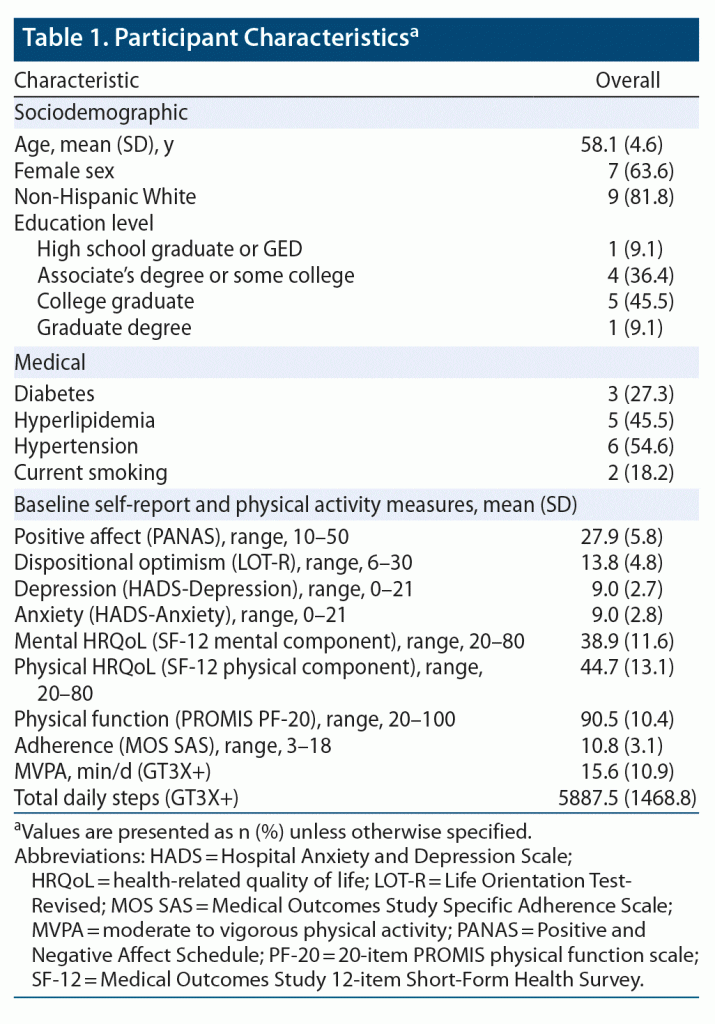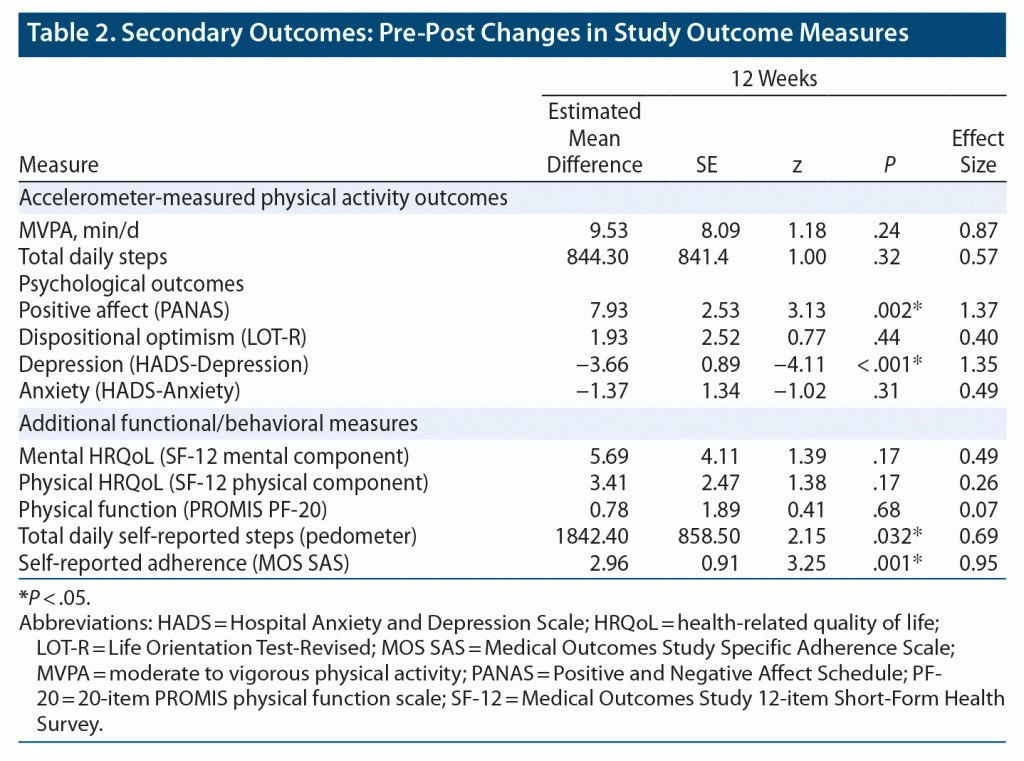ABSTRACT
Background: Many midlife adults (aged 45–64 years) struggle to become physically active in the context of diminished psychological well-being and multiple concurrent stressors, despite the clear association of low physical activity with the development of chronic medical conditions.
Objectives: To assess the feasibility (rates of session completion) and acceptability (participant 0–10 ratings of weekly session ease and utility) of a novel 12-week, phone-delivered, midlife-adapted positive psychology–motivational interviewing (PP-MI) intervention to promote physical activity. Secondary aims were pre-post changes in accelerometer-measured physical activity and self-reported psychological and functional measures.
Methods: A single-arm proof-of-concept trial of the PP-MI intervention was conducted among 11 inactive midlife adults enrolled from the primary care practices of an urban academic medical center. Descriptive statistics were used to assess feasibility and acceptability outcomes, and mixed effects models were used to examine pre-post changes in psychological, functional, and physical activity outcomes from baseline to 12 weeks.
Results: The intervention exceeded a priori thresholds for feasibility and acceptability, with 80.3% session completion across all participants and mean session ratings of 8.3/10 (SD = 2.1). Participants also had medium effect size magnitude improvements in physical activity and psychological outcomes.
Conclusions: This remotely delivered, midlife-specific PP-MI intervention was feasible and well-accepted among inactive midlife adults, supporting next-step testing of this program in a randomized trial.
Trial Registration: ClinicalTrials.gov identifier: NCT04745182
Prim Care Companion CNS Disord 2021;23(4):20m02876
To cite: Huffman JC, Massey CN, Chung WJ, et al. A psychological-behavioral intervention to improve physical activity in midlife adults with low baseline physical activity. Prim Care Companion CNS Disord. 2021;23(4):20m02876.
To share: https://doi.org/10.4088/PCC.20m02876
© Copyright 2021 Physicians Postgraduate Press, Inc.
aHarvard Medical School, Boston, Massachusetts
bDepartment of Psychiatry, Massachusetts General Hospital, Boston, Massachusetts
*Corresponding author: Jeff C. Huffman, MD, Massachusetts General Hospital, 55 Fruit St, Boston, MA 02114 ([email protected]).
Midlife is a critical time in the prevention of heart disease and other chronic medical conditions. Midlife adults (aged 45–64 years) make up more than one-quarter of the US population and represent its fastest growing age group.1 The median age at onset of multiple cardiac risk conditions (eg, hypertension,2 type 2 diabetes3) is during midlife, with the subsequent onset of heart disease immediately after this stage.4
Health behaviors, especially physical activity, play a major role in midlife cardiac health, yet many midlife persons struggle to initiate or maintain adequate physical activity. Physical activity in midlife is independently associated with prevention of heart disease, lower rates of cardiac events, and superior survival,5 but fewer than 20% of midlife adults meet recommended levels of activity.6
The daily challenges faced by midlife adults can interfere with efforts to maintain health.7 Many midlife adults experience substantial time pressure and competing demands related to increased job responsibilities, caregiving of family members, and financial burden.7 These factors conspire to increase stress and lead to limited time for self-care.7,8 Relatedly, psychological well-being, which is prospectively associated with greater physical activity and lower rates of heart disease,9 is lowest during midlife.10
Accordingly, we have developed a multipronged, midlife-targeted program that promotes psychological well-being, facilitates goal setting, and addresses midlife barriers to activity. The program was adapted from an existing physical activity program that combines positive psychology (PP) activities and motivational interviewing (MI) principles11 using qualitative data from midlife adults at cardiac risk8 and existing stress reduction programs.12 In this article, we describe an initial test of the feasibility, acceptability, and impact of the 12-week intervention (The Midlife Activity, Stress Reduction, Time Efficiency, Resilience, and Youthfulness [MASTERY] program) among midlife adults with low baseline physical activity. We hypothesized that the program would surpass a priori metrics for feasibility (sessions completed) and acceptability (participant session ratings) and show pre-post improvements in well-being and objectively measured physical activity.
METHODS
Overview
This was a single-arm proof-of-concept trial of a phone-delivered PP-MI intervention, with content adapted to midlife adults (ClinicalTrials.gov identifier: NCT04745182). Participants were primary care patients enrolled from an urban academic medical center between October 2019 and January 2020. The study was approved by the medical center’s institutional review board prior to completion of any study procedures, and all participants provided written informed consent. The primary goal of the study was to assess intervention feasibility and acceptability, with a secondary goal of exploring the impact of the intervention on physical activity and other outcomes as assessed by effect size differences.
Sample
Study criteria. We included midlife adults (aged 45–64 years at the time of enrollment), with low self-reported baseline physical activity. We defined low physical activity, based on consensus recommendations,13 as < 150 minutes/week of moderate to vigorous physical activity (MVPA), measured using a brief version of the well-validated International Physical Activity Questionnaire14 regarding their activity in the past week (or a typical week if the past 7 days were atypical).
Exclusion criteria included (1) inability to speak English; (2) cognitive impairment precluding participation or informed consent, assessed via a 6-item cognitive screen;15 (3) lack of phone access; (4) a condition precluding completion of MVPA (eg, arthritis, chronic obstructive pulmonary disease); (5) current participation in similar programs (eg, mind-body interventions); and (6) existing coronary artery disease (CAD). Individuals with CAD were excluded given that an ultimate goal of this program was to prevent heart disease and because CAD patients may in some cases have greater restrictions on activity. Existing CAD was defined as a prior acute coronary syndrome (unstable angina or myocardial infarction) or CAD identified via cardiac catheterization (ie, 50% stenosis of the left main artery or 70% stenosis of another coronary artery), derived via patient report and medical record review. We did not exclude patients who had high baseline psychological well-being, as we have found that high baseline well-being does not impede improvement in physical activity in our prior work utilizing PP-based physical activity interventions.11,16 Likewise, to maximize generalizability, we did not require participants to have multiple life stressors, as the stress reduction component was felt likely to help all persons and because other intervention elements (eg, PP and physical activity goal setting) may still provide benefit to those with fewer specific stressors.
Patients were identified via searches of electronic medical records of all 20 primary care practices affiliated with the academic medical center. Patients who were approved by their primary care providers to be approached for the study were sent an opt-out letter, with a subsequent screening phone call for those who did not opt out of contact. During these calls, study staff described the project to potential participants and screened them for study criteria (eg, low MVPA, cognitive impairment). Patients who were interested and eligible then attended a baseline in-person study visit, at which time they provided written informed consent, received an accelerometer to wear for 1 week, and completed baseline self-report assessments. We aimed to enroll 1 participant per week for this initial small proof-of-concept study.
At a second study visit the following week, participants returned the accelerometer (for baseline activity data) and met with a study interventionist, who reviewed the treatment manual and MASTERY program rationale with the participant. The remainder of the intervention was delivered by phone, with weekly calls for 12 weeks. Following the intervention, participants completed a follow-up assessment by phone and received accelerometers by mail, wore them for 1 week, and then returned them by mail.
Intervention
Participants independently completed assigned intervention activities (eg, PP exercises and physical activity goals), then attended 30-minute phone sessions with a trained psychologist study interventionist each week. During these sessions, they reviewed the prior week’s work, considered how to use well-being and physical activity–promoting skills in daily life, and discussed the next week’s assigned activities and rationale (Supplementary Figure 1). The psychologists, who had previously delivered PP and MI–based programs, were trained by the study’s principal investigator (J.C.H.) and project director (C.M.C.) via didactic teaching, manual review, discussion of intervention elements, and role play.
The intervention consisted of 2 components: a PP intervention component that focused on the promotion of well-being and an MI component that focused on applying MI principles and goal setting to promote physical activity. The PP program was composed of 3 4-week thematic modules (gratitude/positive affect, personal strengths, and optimism/meaning), with participants completing distinct exercises (see below) in the given domain during the first 3 weeks. In the fourth (“integration”) week of the module, participants identified the most useful skills from that module and practiced using them in daily life to gain experience and encourage their sustained future practice.
The PP exercises were as follows: gratitude for positive events (week 1), expressing gratitude (week 2), capitalizing on positive events (week 3), using gratitude in daily life (week 4), recalling past success (week 5), using personal strengths (week 6), using perseverance (week 7), using strengths in daily life (week 8), enjoyable and meaningful activities (week 9), performing acts of kindness (week 10), the “good life” (week 11), and using skills in the future (week 12). These exercises were designed to take 10–15 minutes to complete each week. Details of each exercise (and pages from the PP component of the manual) are provided in Supplementary Table 1 and Supplementary Appendix 1. The PP component of the intervention was adapted to midlife persons by providing examples and context common in midlife (eg, juggling numerous responsibilities, caring for family) and including content specific to midlife (eg, performing meaningful activities, as many adults in midlife begin to focus on meaning, purpose, and legacy more distinctly during this life stage17).
The midlife-focused MI portion of all calls (15 minutes) assessed participant motivation to increase physical activity and then planned action steps or used cognitive work to boost motivation. Interventionists used an overall “5As” strategy (ask, advise, assess, assist, arrange) from behavior change theory with participants.18 In all weeks, there was a focus on reviewing the prior week’s goal, tracking physical activity, assessing stage of change, and problem-solving barriers. In addition, each week a specific topic (eg, finding new walking routes, problem-solving midlife-specific barriers) was discussed in detail with participants (Supplementary Table 2). Participants set a physical activity goal each week; they also received an Omron pedometer to assist with measuring activity.
The first 4 weeks of the MI component represented a “core MI” module based on our original PP-MI intervention. This module introduced general skills for increasing physical activity used throughout the program, including considering importance and confidence in change, tracking activity, setting goals via a “SMART” framework, and addressing barriers (eg, by identifying new walking routes). The rest of the MI component was created specifically for this intervention. We used midlife-specific modules that focused on common midlife stressors that were identified as barriers to physical activity in our prior interviews of midlife adults.8 First, in weeks 5–7, given the major emphasis on time management as a barrier to activity in our qualitative work, all participants completed a time management module adapted from published programs19–21 that focused on breaking tasks into smaller chunks, using organizational tools, and other strategies. Next, following a week 8 session reviewing overall physical activity progress, participants chose 1 of 3 modules focused on a midlife-specific barrier (occupational, financial, or caregiving) to complete for weeks 9–11, all adapted from published programs,22–24 given that these were identified as important barriers in midlife persons that inhibited their physical activity. In all modules, the initial session focused on identifying the barrier’s relationship to low activity (with a focus on problem solving), the second session discussed implementing changes and reducing stress, and the final session centered on using social resources to manage the barrier and optimize physical activity. See Supplementary Table 2 and Supplementary Appendix 2 for detail about the weekly MI-based topics and midlife-specific modules, along with pages from the MI component of the manual.
All interventionists were trained by the study principal investigator (J.C.H.) and intervention supervisors (C.M.C., C.N.M.) using our established protocol for psychological-behavioral interventions. All phone sessions were recorded, and sessions were played/reviewed at weekly meetings between the supervisors and interventionists to ensure that all elements were delivered with high fidelity.
Outcomes
The primary aims of the study were feasibility and acceptability. As in prior projects, we calculated the rate of phone sessions fully completed (completing the phone call, completion of the prior week’s PP activity, and setting a new physical activity goal) as our metric for feasibility. A priori, we set 70% completion of sessions across all participants and a majority of participants completing more than half of the sessions as our thresholds for success based on prior work.11,25 For acceptability, participants provided 0–10 ratings of the ease and utility (ease: 0 = very difficult, 10 = very easy; utility: 0 = not at all useful, 10 = very useful) of the PP and MI intervention activities/content each week during intervention calls for a total of 4 weekly ratings. We calculated mean ratings of sessions across all participants and denoted mean scores > 7.0/10 for both ease and utility as our threshold for success based on prior work using similar ratings for phone-based behavioral interventions.11,25
As secondary outcomes, we assessed accelerometer-measured physical activity (main secondary outcome) and self-report measures. Specifically, we measured physical activity (MVPA and steps) via the well-validated and reliable Actigraph GT3×+ accelerometer,26 using 1,952 counts/minute as the threshold for MVPA as per the traditional Freedson cutpoint for accelerometer-measured MVPA,27 and requiring at least 4 days of ≥ 8 hours of wear per measurement.
For self-report psychological and functional measures, we assessed positive affect via the Positive and Negative Affect Schedule positive affect items,28 optimism via the Life Orientation Test-Revised,29 depression and anxiety with the Hospital Anxiety and Depression Scale,30 physical function via the 20-item PROMIS physical function scale,31 and health-related quality of life (HRQoL) using the Medical Outcomes Study 12-item Short-Form Health Survey.32 Finally, throughout the study, interventionists informally recorded participant feedback on intervention modality, feasibility of phone sessions, burden and applicability of intervention content, utility of the midlife modules, and overall impact of the program.
Analysis
For our feasibility and acceptability outcomes, we used descriptive statistics (means, SDs, proportions) to calculate rates of session completion and mean ease/utility scores. We also used these basic statistics to account for numbers of patients approached, enrolled, and retained. Feedback from participants was discussed among interventionists and the principal investigator (J.C.H.) during intervention review sessions during and after the study.
For pre-post changes, we utilized mixed regression models, with a categorical effect of time and an unstructured covariance matrix, to assess changes in self-report and physical activity metrics. We utilized these models because they allow for inclusion of all participants, even those with some missing data, to generate an estimated mean difference in outcomes. We focused on effect size (calculated as the time coefficient outcome divided by the standard deviation of the residual for the measure) rather than statistical significance (P < .05) given the small sample and secondary nature of these outcomes. All statistical tests were 2-tailed, and all analyses were conducted via Stata version 15.2 (Statacorp, College Station, Texas).
RESULTS
Overall, 11 participants were enrolled in the trial (participant characteristics are presented in Table 1 and Supplementary Figure 2 provides a CONSORT flow diagram), of whom 10 (91%) provided follow-up data. Regarding the midlife modules, 4 chose to complete the occupational stress module, 4 chose to complete the financial stress module, and 3 chose to complete the module on caregiving stress.
Regarding feasibility, 80.3% of all possible phone sessions (106/132) were fully completed, and 8 participants (72.7%) completed at least half of the sessions. For acceptability, participants’ mean rating of the ease and utility of the PP and MI intervention components was 8.3/10 (SD = 2.1) across all 4 rating types, with both PP and MI components being rated as easy to complete (PP ease: 7.9, SD = 2.2; MI ease: 8.1, SD = 2.2) and useful (PP utility: 8.9, SD = 2.0; MI utility: 8.5, SD = 2.0).
Regarding secondary outcomes (Table 2), for the main secondary outcome of objectively measured physical activity, participants increased their physical activity with medium to large effect size magnitude changes (MVPA: estimated mean difference = 9.53 minutes, SE = 8.09, effect size = 0.87; total steps: estimated mean difference = 844.3 steps, SE = 841.4, effect size = 0.57). For steps measured via pedometer, we also observed large effect size magnitude changes in steps (effect size = 0.69). Finally, we observed medium to large effect size magnitude improvements in positive affect, depression, anxiety, and mental HRQoL (effect size = 0.49–1.37), with smaller changes in dispositional optimism and physical function.
Participant feedback noted that the intervention was experienced as feasible and enjoyable by most participants, though in several cases the 12-week duration of the phone sessions felt burdensome to participants, who felt that a shorter phone-based intervention with shorter booster content (eg, text messages) would be efficient and more feasible. The midlife modules were experienced as a good fit, and, overall, the majority of participants reported learning skills that would assist them in being physically active beyond the intervention period.
DISCUSSION
In this initial proof-of-concept trial of a multipronged, phone-delivered, midlife-specific physical activity intervention for adults aged 45–64 years with low baseline physical activity, we found that the intervention was feasible and well-accepted, exceeding thresholds on all feasibility and acceptability metrics. We also reached our enrollment target of approximately 1 participant enrolled per week. Over 80% of all possible sessions were completed, and participants reported the PP and MI components to be easy and useful. They also found the midlife-specific content relevant to their circumstances, with participants selecting a range of different modules based on their specific situation. These findings are consistent with prior work11,25 finding similar rates of session completion and participant ratings in patients with cardiovascular disease.
The intervention was associated with substantial improvements in objectively measured physical activity in this group of low-active midlife adults. Physical activity is strongly linked with lower rates of cardiac disease, other chronic medical conditions, and mortality.33 Increasing physical activity during midlife—when most chronic conditions appear—is a key public health issue, and data suggest that it is difficult for initially inactive persons to increase their activity in the context of managing multiple sources of stress and responsibility. This program—specifically adapted to midlife persons and allowing some tailoring of intervention content to fit their sources of stress—may therefore represent a promising approach in this age group.
We also found that the intervention was associated with improvements in psychological measures, including positive affect, depression, and anxiety, with generally medium effect size magnitude improvements over 12 weeks. These findings are consistent with the impact of combined PP and MI programs in other high-risk populations, such as those with diabetes or a recent cardiac event.11,25 Such findings may be important given that greater positive affect has been independently linked to lower rates of mortality,9 and lower depression is likewise linked to lower rates of heart disease and death.34
This initial study had important limitations. It examined a systematically delivered intervention with trained interventionists and ongoing assessments for fidelity, and it utilized objective measures of activity via research-grade accelerometry. At the same time, this was a small, 1-arm initial proof-of-concept trial. The sample size was small, recruitment was from a single academic medical center, follow-up was limited to 12 weeks, and there was no control condition. We had no data on socioeconomic status, and the sample was limited in educational and racial/ethnic diversity and did not include members of the youngest (aged 45–50 years) component of midlife adults. Feedback from participants was systematically recorded and discussed, but it was not obtained, synthesized, and analyzed via formal qualitative methods. Much additional work is needed before any claims can be made about the effectiveness of the MASTERY program in real-world clinical settings.
In conclusion, this proof-of-concept trial found a phone-delivered, midlife-adapted PP-MI intervention to be feasible, well-accepted, and associated with pre-post improvements in physical activity, psychological measures, and HRQoL. Larger, longer, and well-controlled studies, in more diverse samples, are needed to better assess the impact of this intervention.
Submitted: November 22, 2020; accepted February 16, 2021.
Published online: July 29, 2021.
Potential conflicts of interest: None.
Funding/support: Time for analysis and article preparation was funded by the National Heart, Lung, and Blood Institute through grant K23HL123607 (C.M.C.) and by the National Institute of Diabetes and Digestive and Kidney Diseases through grant R21DK109313 (J.C.H.). The project was also supported by the National Center for Advancing Translational Science through grant 1UL1TR002541-01.
Previous presentation: Project presented in oral form at the 67th Annual Meeting of the Academy of Consultation-Liaison Psychiatry; November 12–13, 2020; virtual conference.
Supplementary material: Supplementary material follows this article.
References (34)

- S. Census Bureau. 2010 Census Briefs. https://www.census.gov/prod/cen2010/briefs/c2010br-03.pdf. Published 2013. Accessed September 29, 2019.
- Fryer CD, Ostchega Y, Hales CM, et al. Hypertension Prevalence and Control Among Adults: United States, 2015–2016. NCHS Data Brief, No 289. Hyattsville, MD: National Center for Health Statistics; 2017.
- Centers for Disease Control and Prevention. National Diabetes Statistics Report. Estimates of Diabetes and Its Burden in the United States. CDC website. https://www.cdc.gov/diabetes/pdfs/data/statistics/national-diabetes-statistics-report.pdf. Published 2017. Accessed December 27, 2019.
- Benjamin EJ, Muntner P, Alonso A, et al; American Heart Association Council on Epidemiology and Prevention Statistics Committee and Stroke Statistics Subcommittee. Heart Disease and Stroke Statistics-2019 Update: a report from the American Heart Association. Circulation. 2019;139(10):e56–e528. PubMed CrossRef
- Kodama S, Tanaka S, Heianza Y, et al. Association between physical activity and risk of all-cause mortality and cardiovascular disease in patients with diabetes: a meta-analysis. Diabetes Care. 2013;36(2):471–479. PubMed CrossRef
- Tucker JM, Welk GJ, Beyler NK. Physical activity in US: adults compliance with the Physical Activity Guidelines for Americans. Am J Prev Med. 2011;40(4):454–461. PubMed CrossRef
- Lachman ME, Teshale S, Agrigoroaei S. Midlife as a pivotal period in the life course: balancing growth and decline at the crossroads of youth and old age. Int J Behav Dev. 2015;39(1):20–31. PubMed CrossRef
- Madva EN, Gomez-Bernal F, Millstein RA, et al. Magnitude and sources of distress in mid-life adults with chronic medical illness: an exploratory mixed-methods analysis. Psychol Health Med. 2018;23(5):555–566. PubMed CrossRef
- Kubzansky LD, Huffman JC, Boehm JK, et al. Positive psychological well-being and cardiovascular disease: JACC Health Promotion Series. J Am Coll Cardiol. 2018;72(12):1382–1396. PubMed CrossRef
- Blanchflower DG, Oswald AJ. Is well-being U-shaped over the life cycle? Soc Sci Med. 2008;66(8):1733–1749. PubMed CrossRef
- Huffman JC, Feig EH, Millstein RA, et al. Usefulness of a positive psychology-motivational interviewing intervention to promote positive affect and physical activity after an acute coronary syndrome. Am J Cardiol. 2019a;123(12):1906–1914. PubMed CrossRef
- Kopf S, Oikonomou D, Hartmann M, et al. Effects of stress reduction on cardiovascular risk factors in type 2 diabetes patients with early kidney disease: results of a randomized controlled trial (HEIDIS). Exp Clin Endocrinol Diabetes. 2014;122(6):341–349. PubMed CrossRef
- US Department of Health and Human Services. Physical Activity Guidelines for Americans, 2nd Edition. Health.gov website. Accessed May 23, 2020. https://health.gov/paguidelines/second-edition/pdf/Physical_Activity_Guidelines_2nd_edition.pdf
- Craig CL, Marshall AL, Sjöström M, et al. International Physical Activity Questionnaire: 12-country reliability and validity. Med Sci Sports Exerc. 2003;35(8):1381-1395.
- Callahan CM, Unverzagt FW, Hui SL, et al. Six-item screener to identify cognitive impairment among potential subjects for clinical research. Med Care. 2002;40(9):771–781. PubMed CrossRef
- Celano CM, Albanese AM, Millstein RA, et al. Optimizing a positive psychology intervention to promote health behaviors after an acute coronary syndrome: the Positive Emotions After Acute Coronary Events III (PEACE-III) randomized factorial trial. Psychosom Med. 2018;80(6):526–534. PubMed CrossRef
- Lachman ME. Development in midlife. Annu Rev Psychol. 2004;55(1):305–331. PubMed CrossRef
- Dosh SA, Holtrop JS, Torres T, et al. Changing organizational constructs into functional tools: an assessment of the 5 A’s in primary care practices. Ann Fam Med. 2005;3(suppl 2):S50–S52. PubMed CrossRef
- McNeil MP. Time management: Finding balance to do it “all.” In: Anderson DS, ed. Further Wellness Issues for Higher Education: How to Promote Student Health During and After College. New York, NY: Routledge/Taylor & Francis Group; 2017:85–100.
- Safren SA, Sprich SE, Perlman CA, et al. Mastering Your Adult ADHD: A Cognitive-Behavioral Treatment Program. 2nd ed. New York, NY: Oxford University Press; 2007.
- Wang P, Wang X. Effect of time management training on anxiety, depression, and sleep quality. Iran J Public Health. 2018;47(12):1822–1831. PubMed
- Jacobs F, Easterbrooks MA, Goldberg J, et al. Improving adolescent parenting: results from a randomized controlled trial of a home visiting program for young families. Am J Public Health. 2016;106(2):342–349. PubMed CrossRef
- Richardson KM, Rothstein HR. Effects of occupational stress management intervention programs: a meta-analysis. J Occup Health Psychol. 2008;13(1):69–93. PubMed CrossRef
- Schulz R, Martire LM. Family caregiving of persons with dementia: prevalence, health effects, and support strategies. Am J Geriatr Psychiatry. 2004;12(3):240–249. PubMed CrossRef
- Huffman JC, Millstein RA, Feig EH, et al. A positive psychology-motivational interviewing intervention for physical activity in type 2 diabetes: the BEHOLD-8 controlled clinical trial. Academy of Consultation-Liaison Psychiatry Annual Meeting; November 14, 2019; San Diego, CA.
- Aadland E, Ylvisåker E. Reliability of the Actigraph GT3X+ accelerometer in adults under free-living conditions. PLoS One. 2015;10(8):e0134606. PubMed CrossRef
- Freedson PS, Melanson E, Sirard J. Calibration of the Computer Science and Applications, Inc. accelerometer. Med Sci Sports Exerc. 1998;30(5):777–781. PubMed CrossRef
- Crawford JR, Henry JD. The Positive and Negative Affect Schedule (PANAS): construct validity, measurement properties and normative data in a large non-clinical sample. Br J Clin Psychol. 2004;43(Pt 3):245–265. PubMed CrossRef
- Scheier MF, Carver CS, Bridges MW. Distinguishing optimism from neuroticism (and trait anxiety, self-mastery, and self-esteem): a reevaluation of the Life Orientation Test. J Pers Soc Psychol. 1994;67(6):1063–1078. PubMed CrossRef
- Bjelland I, Dahl AA, Haug TT, et al. The validity of the Hospital Anxiety and Depression Scale: an updated literature review. J Psychosom Res. 2002;52(2):69–77. PubMed CrossRef
- Jensen RE, Potosky AL, Reeve BB, et al. Validation of the PROMIS physical function measures in a diverse US population-based cohort of cancer patients. Qual Life Res. 2015;24(10):2333–2344. PubMed CrossRef
- Ware J Jr, Kosinski M, Keller SDA. A 12-item Short-Form Health Survey: construction of scales and preliminary tests of reliability and validity. Med Care. 1996;34(3):220–233. PubMed CrossRef
- Saint-Maurice PF, Coughlan D, Kelly SP, et al. Association of leisure-time physical activity across the adult life course with all-cause and cause-specific mortality. JAMA Netw Open. 2019;2(3):e190355. PubMed CrossRef
- Jha MK, Qamar A, Vaduganathan M, et al. Screening and management of depression in patients with cardiovascular disease: JACC State-of-the-Art Review. J Am Coll Cardiol. 2019;73(14):1827–1845. PubMed CrossRef
Please sign in or purchase this PDF for $40.






